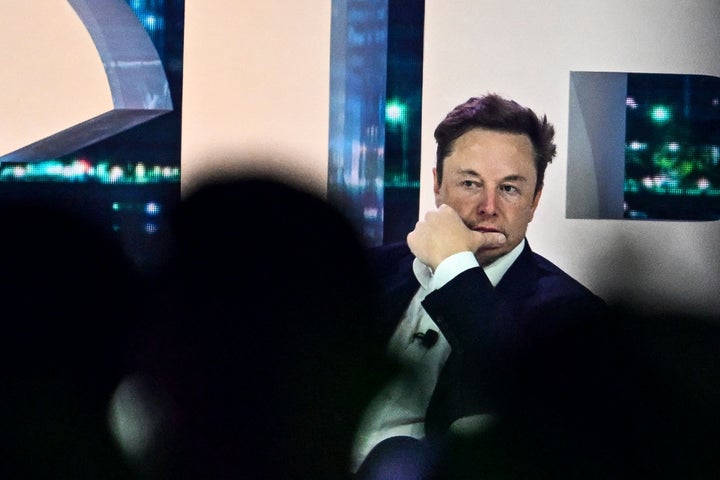
A new week, a new arbitrary dictate from Elon Musk.
The Twitter CEO has laid out rules for his company like they’re the Starship rocket: Here one second, gone the next.
This time, the government-subsidized billionaire has threatened to give National Public Radio’s Twitter handle to “another company” because NPR has stopped tweeting — the result of NPR protesting another Musk whim, namely, him falsely labeling the company “state-affiliated” and “government-funded.”
But once again, Musk is making up the rules as he goes. “Our policy is to recycle handles that are definitively dormant,” he told NPR in an email. That’s different from Twitter’s actual written policy, which states that “inactivity is based on logging in,” not tweeting. (That policy itself was also recently changed from requiring users to log in “every 6 months” to “every 30 days.”)
“Elon Musk displaying classic scam behavior, announcing a steady stream of ‘changes’ to Twitter at a pace just fast enough to make sure most of his fans don’t take a minute to pause and reflect on how bad he’s failing at the prior plans,” digital researcher Jared Holt observed recently. Or as TechCrunch put it, “Welcome to Elon Musk’s Twitter, where the rules are made up and the check marks don’t matter.”
Musk’s Twitter regime — now just over six months old — is a string of broken promises and ignored rules. Here are a few of the most significant flip-flops.
Buying Twitter In The First Place
Musk committed his first reversal before he even owned the company — initiating a series of panicked attempts to get out of his binding purchase offer.
In April 2022, after becoming a significant shareholder in Twitter, Musk agreed to buy the company for a surprisingly high $44 billion, or $54.20 a share, saying Twitter had “tremendous potential.” “We believe it is the best path forward for Twitter’s stockholders,” said Brett Taylor, then Twitter’s board chair.
The era of good feelings didn’t last long, as signs emerged of Musk attempting to sabotage the deal. In May, he said the transaction was “on hold,” and in June, he threatened to walk away from the deal. In July, he attempted to cancel the deal altogether, claiming Twitter had withheld information on ’“the prevalence of fake or spam accounts” on the platform, an allegation the company denied.
Twitter, for its part, pointed out that Musk waived due diligence before making his purchase offer. Ultimately, the company had to sue to force the sale, saying in their complaint that “From the outset, defendants’ information requests were designed to try to tank the deal.” Last month, Musk acknowledged to the BBC that he was trying to get out of the deal, and only went through with the purchase because he believed he would be legally required to do so.
The same pattern played out before the ownership struggle, over a board seat. After the revelation last April that Musk had purchased a 9% stake in Twitter, then-CEO Parag Agrawal announced, “I’m excited to share that we’re appointing @elonmusk to our board!” Just a few days later, Agrawal announced that Musk had decided to skip the board seat. “I believe this is for the best,” Agrawal said, before warning of “distractions ahead.”
Working With Civil Rights Groups
Musk’s failure to keep his promises extended to Twitter’s extremism policy.
Musk initially said that he would work with a panel of civil rights leaders and others to vet the potential return of accounts that had been banned by previous management for rules violations.
“Twitter will not allow anyone who was de-platformed for violating Twitter rules back on platform until we have a clear process for doing so, which will take at least a few more weeks,” he said in early November last year. “Twitter’s content moderation council will include representatives with widely divergent views, which will certainly include the civil rights community and groups who face hate-fueled violence.”
Instead, Musk acted unilaterally to reinstate not just former President Donald Trump’s account, but a slew of toxic bigots and online harassers, declaring a policy of “amnesty.”
Musk claimed to have abandoned the content moderation council because “a large coalition of political/social activist groups” had broken a deal not to try and starve Twitter of advertising revenue. (Activists disagreed.)
Right-wing extremists on Twitter — including multiple white supremacists — subsequently benefited from both Musk’s lax anti-extremism enforcement as well as his policy of liberally distributing blue check marks to anyone with a few dollars to spare.
One account that had been suspended prior to Musk’s Twitter ownership, “Racial Consciousness,” bragged to its followers last month that it had been “verified.” The account, which had nearly 64,000 followers, described itself as a “National Socialist” and published posts including an audio narration of Adolf Hitler’s “Mein Kampf” set against a video montage of rats. It has since been suspended again.
Such voices may benefit from Twitter’s megaphone: The Washington Post reported in March that Twitter’s algorithm amplified far-right voices into the timelines of several experimental accounts the paper created to test the website’s hate speech policy — despite Musk’s pledge in November that “New Twitter policy is freedom of speech, but not freedom of reach.”
‘Manually Authenticating’ Twitter Blue Accounts
As soon as Musk’s first paid “Twitter Blue” check marks hit the internet in November, observers quickly realized he was letting anyone buy what used to be known as a “verification” check for $8, without any actual ... verification. Cue the influx of fraud accounts, such as one that prompted a momentary panic in drugmaker Eli Lilly’s stock price after More Perfect Union senior writer Sean Morrow made an account impersonating the company and said that insulin would now be free.
Musk paused the program, saying that the relaunched program would only give users a coveted check after they were “manually authenticated.” A few days later, Twitter’s corporate account referred to this simply as being “reviewed.” Nevertheless, fake accounts continued to proliferate: In January, a Washington Post tech columnist successfully impersonated Sen. Ed Markey (D-Mass.) — the columnist’s second time impersonating the senator — and published an article about it before Twitter noticed.
Now, Twitter Blue users have to provide a “verified phone number” and be “approved.” But fraudulent accounts still abound. Last month, a fake account purporting to represent the Rapid Support Forces — the Sudanese paramilitary group — falsely announced that the group’s leader had died of injuries sustained in battle. The fraudulent account had a Twitter Blue check mark, while the group’s real account did not, a fact that has since changed. According to Twitter’s public numbers, the false tweet was viewed 1 million times, Vice reported.
Separately, Twitter gave the satire account @DisneyJuniorUK a gold check mark, falsely marking it as an “official organization.”
“Someone fucking pinch me or something,” the account wrote shortly before being suspended. Around the same time, fake accounts purporting to be Chicago Mayor Lori Lightfoot and the Chicago and Illinois departments of transportation claimed that a major expressway in the city would be officially “closed to private vehicles.” Again, fake.
The ‘False Endorsement’ Fiasco
After initially promising in February that “Legacy blue checks will be removed soon,” Musk instead dragged his feet and blurred the lines between legacy verified accounts and Twitter Blue subscribers, attaching notes to users’ check marks that stated, “This account is verified because it’s subscribed to Twitter Blue or is a legacy verified account.” This effectively erased the last remaining indicator differentiating notable figures from paying users.
Musk finally pulled the trigger on in April, taking the verification badges off of the accounts of journalists and celebrities whose identities had been verified under the old regime (including all HuffPost reporters) and keeping them on paid accounts.
Except, not so fast: Not only did Musk assign blue check marks to celebrity accounts who weren’t paying for Twitter Blue — including deceased celebrities like Chadwick Boseman and Norm Macdonald — the check marks also falsely indicated that these celebrities were, in fact, paying customers of Musk’s. “This account is verified because they are subscribed to Twitter Blue and verified their phone number,” the badges falsely read.
Some legal scholars wondered aloud whether Musk could face a “false endorsement” lawsuit from the likes of author Stephen King or other Musk critics who objected to the false implication that they supported the new Twitter CEO’s product. This week, Musk changed course yet again. Now, check marks simply report, “This account is verified.”
Committing To Free Speech
Of course, these examples are just a handful among many. Musk breaks promises large and small — like his failed pledge to make “major” decisions by public poll, his unrealistic timelines for sharing revenue with creators, and, yes, his unfulfilled promise to step down as CEO.
But his grandest abdication has been on the issue of free speech — ostensibly the main reason he bought the platform in the first place.
A year ago, soon after Musk and Twitter reached a deal that would ultimately result in Musk owning Twitter (see above), Musk wrote, “The extreme antibody reaction from those who fear free speech says it all,” and added, “I am against censorship that goes far beyond the law.”
But despite branding himself a “free speech absolutist,” Musk has been anything but as Twitter CEO.
Musk’s tenure has included restrictions on interacting with links to Twitter competitor Substack and suspending journalists and coders who posted about an apparent sore spot for Musk: publicly available information regarding the movements of his private jet.
Twitter also bent to the will of the Indian government and blocked a BBC film about Prime Minister Narendra Modi. When asked about the activity, Musk claimed ignorance, saying he was “not aware of this particular situation.” (To be fair: YouTube also complied with the Indian government’s orders and took down the documentary in India, though that company said it was responding to copyright claims.
Musk’s seemingly conditional view of free speech works in the other direction, as well: In March, Platformer reported that for months, Twitter had maintained a list of around 35 VIP accounts for which it offered increased visibility on Twitter, alongside Musk. And Twitter now explicitly offers paid Twitter Blue subscribers “prioritized rankings in conversations and search.”
One of Musk’s core promises is that Twitter can make a profit. “The natural potential here for Twitter revenue is gigantic,” he said in March, adding that he thinks the company can be cash-flow positive in this fiscal quarter.
But he also took on massive debt servicing costs to complete the deal, and revenue tumbled during his first chaotic months. If Musk can’t keep his promise of profitability, it may be his last failure atop the company when those debt costs come due.
